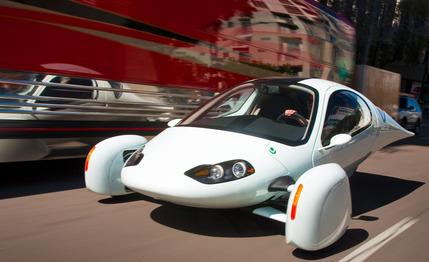
 First Drive Review
First Drive Review
“It’s a game changer.” “It’s an environmental champion.” “This car will revolutionize the way we think about transportation.” We hear this kind of hopeful hype about a lot of vehicles—off-hand, we can think of the Tesla roadster, Chevrolet Volt, and Fisker Karma—and sometimes, it even rings true. But few pieces of fanciful transportation have seemed as far-fetched, at least at first glance, as the 2e, scheduled to be produced just six months from now by California-based Aptera Motors. We recently paid the company a visit to take a quick spin in two of its latest prototypes and to see how close this wingless bird is to hatching.
Built in—Where Else?—California
A tour of the spotless Aptera facilities, located in Vista, California, gave us a glimpse of where the first production models will be built, some 5000 per year, according to the company. The Aptera’s 300-pound composite body will be made off-site at a nearby factory, and an additional production facility is scheduled and will be capable of building another 20,000 or so Apteras once it comes online. At this early stage, most of the space in the production area was open, but several unpainted body shells were sprinkled about, as well as a few early prototypes, two of which we would be able to drive. One featured a near-production-spec interior, while the other was a mule on which Aptera was tweaking the suspension geometry and the location of battery components.
Bigger Than Expected
Aptera is Greek for “wingless flight,” the company says, and the little teardrop two-seater indeed does look as though it could fly, if it had actual wings in place of its skinny front tires encased in “wheel pants.” In spite of its curious shape and three-wheel configuration, the two-passenger Aptera has far more style and presence—and far less dorkiness—than is conveyed in pictures. Sure, from some angles—particularly from up high—the lack of outboard rear wheels looks bizarre. But at a whopping 77 inches, the front track is unexpectedly wide, and the tail is high enough to serve as a buffet table. The LED taillamps double as a charge indicator when the vehicle is plugged in, illuminating in 25-percent increments from left to right across the back. A full charge is possible in eight hours from a 110-volt outlet or two to four hours with a 220-volt source. The HID headlamps feature flush-fitting glass, as do the two-piece side windows, rear quarter-windows, and skinny backlight. The latter is integrated into a hatchback that is set so far inboard that loading cargo will certainly be a Herculean challenge. The rooftop can be fitted with solar cells to power a ventilation system that will keep the interior and exterior temperatures closely matched.
Our first drive was in the prototype with the real interior. Slipping inside the 2e was easy enough, but the process of sliding under the door and then swinging your legs up over the threshold might not be too easy for the arthritic. An upcoming design change is said to swing the rearmost edge of the door more forward, getting it out of the way of your head. Once situated in the thin, manually adjustable seats, passengers find themselves separated only by a thin console and an even thinner armrest. With such inboard positioning, the cabin offers head- and elbowroom in the range of a Smart Fortwo’s, only with several more feet of cargo space in the tapered shell behind the passengers.
Modest Amenities, Abundant Technologies
Lightweight, recycled materials abound inside the 2e, yet the environment is as fresh and clean as a Pinkberry frozen yogurt shop. The dashboard is simple, with an LCD digital monitor in front of the driver and a center-mounted computer readout that will offer many layers of functionality. According to Aptera, those include the operation of a number of available audio, communications, and navigation systems and, of course, vital vehicle systems.
The 2e’s ergonomics are relatively sound—i.e., the pedals are down by your feet, and turn stalks are where one would expect them to be, although we’re not sure if the capacitive-touch “buttons” on the center stack (à la Chevy Volt) will be easy to locate at speed. The windshield offers a wide and vast view of the road ahead and the glossy skirted wheels on either side, although the view out the back is about as expansive as that from an ’84 Lamborghini Countach. A rearview camera will be on the options list, and that would be the first box we’d check.